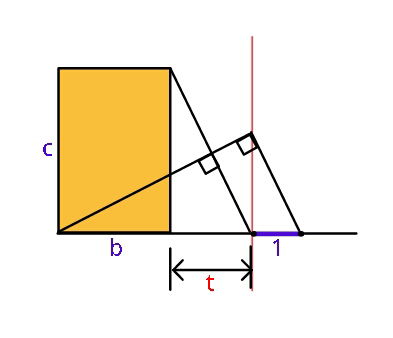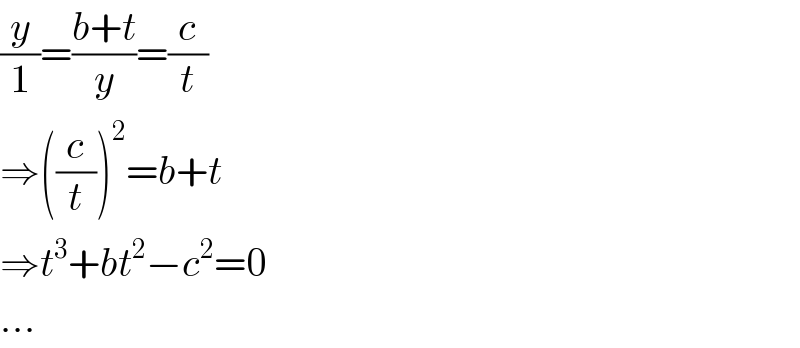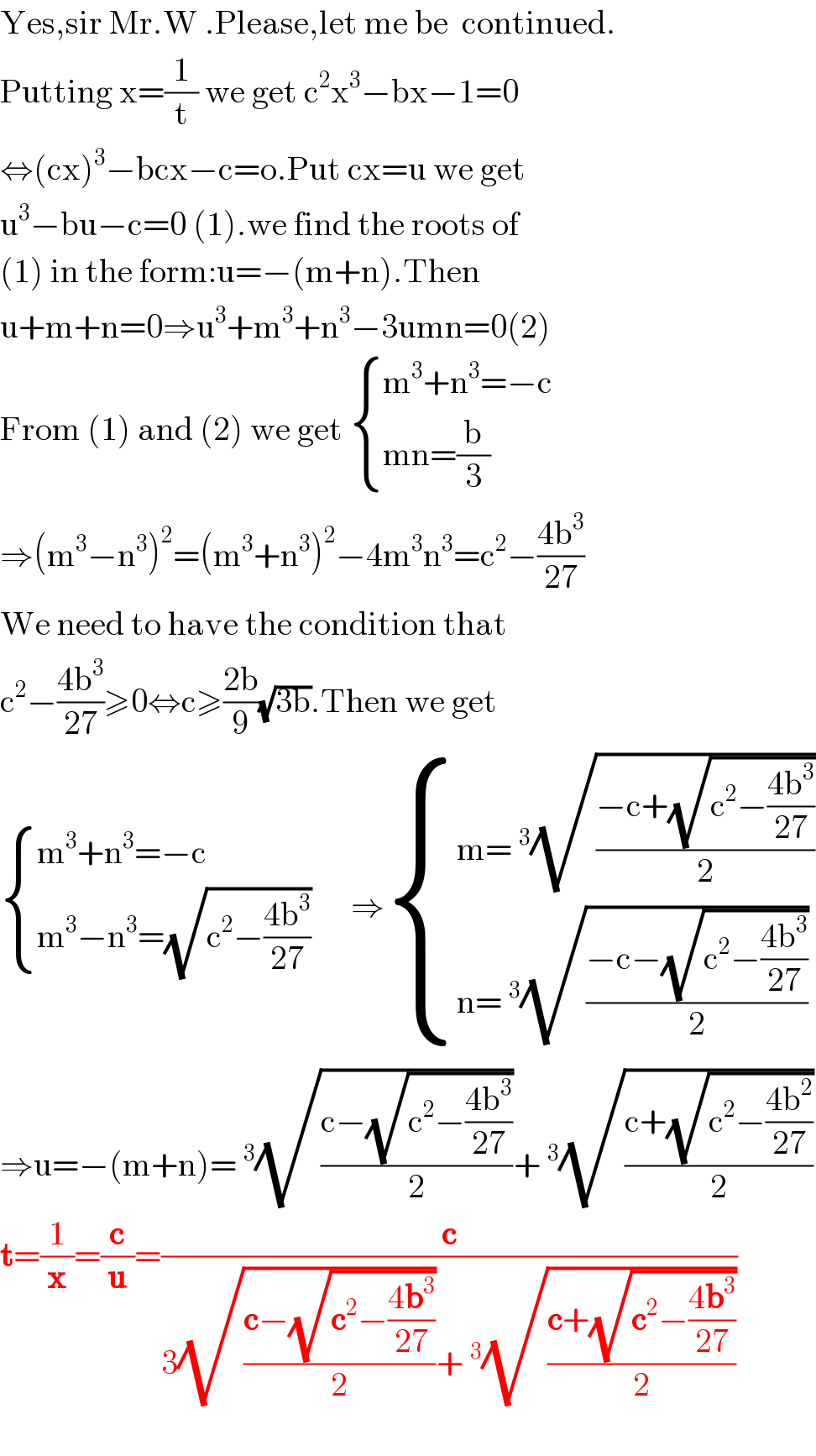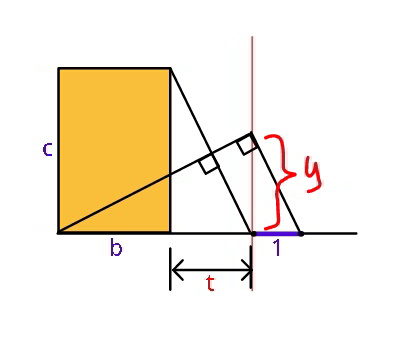Question Number 100146 by ajfour last updated on 25/Jun/20

Commented by bemath last updated on 25/Jun/20

$$\:\:\:\:\:\:\mathrm{t}\:=\:\frac{\mathrm{c}^{\mathrm{2}} −\mathrm{2b}−\mathrm{1}}{\mathrm{2}\left(\mathrm{b}+\mathrm{1}\right)} \\ $$
Commented by ajfour last updated on 25/Jun/20
![clearly (√(b+t))=(c/t) or (b+t)t^2 = c^2 let me check (b+((c^2 −2b−1)/(2(b+1))))[((c^2 −2b−1)/(2(b+1)))]^2 ≠ c^2 please check your answer sir, or post your workings..](https://www.tinkutara.com/question/Q100170.png)
$${clearly}\:\:\sqrt{{b}+{t}}=\frac{{c}}{{t}} \\ $$$${or}\:\:\:\left({b}+{t}\right){t}^{\mathrm{2}} =\:{c}^{\mathrm{2}} \\ $$$${let}\:{me}\:{check} \\ $$$$\:\:\:\left({b}+\frac{{c}^{\mathrm{2}} −\mathrm{2}{b}−\mathrm{1}}{\mathrm{2}\left({b}+\mathrm{1}\right)}\right)\left[\frac{{c}^{\mathrm{2}} −\mathrm{2}{b}−\mathrm{1}}{\mathrm{2}\left({b}+\mathrm{1}\right)}\right]^{\mathrm{2}} \\ $$$$\:\:\:\:\:\:\:\:\:\:\neq\:{c}^{\mathrm{2}} \\ $$$${please}\:{check}\:{your}\:{answer}\:{sir}, \\ $$$${or}\:{post}\:{your}\:{workings}.. \\ $$
Commented by ajfour last updated on 25/Jun/20

$${Find}\:{t}\:{in}\:{terms}\:{of}\:{b},\:{c}\:. \\ $$
Answered by mr W last updated on 25/Jun/20

$$\frac{{y}}{\mathrm{1}}=\frac{{b}+{t}}{{y}}=\frac{{c}}{{t}} \\ $$$$\Rightarrow\left(\frac{{c}}{{t}}\right)^{\mathrm{2}} ={b}+{t} \\ $$$$\Rightarrow{t}^{\mathrm{3}} +{bt}^{\mathrm{2}} −{c}^{\mathrm{2}} =\mathrm{0} \\ $$$$… \\ $$
Commented by ajfour last updated on 25/Jun/20

$${thanls}\:{sir},\:{i}\:{hope}\:{someday} \\ $$$${some}\:{geometry}\:{shall}\:{pave}\:{the} \\ $$$${way}..! \\ $$
Commented by bemath last updated on 25/Jun/20

$$\mathrm{where}\:\mathrm{becomes}\:\mathrm{y}? \\ $$
Commented by 1549442205 last updated on 25/Jun/20

$$\mathrm{Yes},\mathrm{sir}\:\mathrm{Mr}.\mathrm{W}\:.\mathrm{Please},\mathrm{let}\:\mathrm{me}\:\mathrm{be}\:\:\mathrm{continued}. \\ $$$$\mathrm{Putting}\:\mathrm{x}=\frac{\mathrm{1}}{\mathrm{t}}\:\mathrm{we}\:\mathrm{get}\:\mathrm{c}^{\mathrm{2}} \mathrm{x}^{\mathrm{3}} −\mathrm{bx}−\mathrm{1}=\mathrm{0} \\ $$$$\Leftrightarrow\left(\mathrm{cx}\right)^{\mathrm{3}} −\mathrm{bcx}−\mathrm{c}=\mathrm{o}.\mathrm{Put}\:\mathrm{cx}=\mathrm{u}\:\mathrm{we}\:\mathrm{get} \\ $$$$\mathrm{u}^{\mathrm{3}} −\mathrm{bu}−\mathrm{c}=\mathrm{0}\:\left(\mathrm{1}\right).\mathrm{we}\:\mathrm{find}\:\mathrm{the}\:\mathrm{roots}\:\mathrm{of}\: \\ $$$$\left(\mathrm{1}\right)\:\mathrm{in}\:\mathrm{the}\:\mathrm{form}:\mathrm{u}=−\left(\mathrm{m}+\mathrm{n}\right).\mathrm{Then} \\ $$$$\mathrm{u}+\mathrm{m}+\mathrm{n}=\mathrm{0}\Rightarrow\mathrm{u}^{\mathrm{3}} +\mathrm{m}^{\mathrm{3}} +\mathrm{n}^{\mathrm{3}} −\mathrm{3umn}=\mathrm{0}\left(\mathrm{2}\right) \\ $$$$\mathrm{From}\:\left(\mathrm{1}\right)\:\mathrm{and}\:\left(\mathrm{2}\right)\:\mathrm{we}\:\mathrm{get}\:\begin{cases}{\mathrm{m}^{\mathrm{3}} +\mathrm{n}^{\mathrm{3}} =−\mathrm{c}}\\{\mathrm{mn}=\frac{\mathrm{b}}{\mathrm{3}}}\end{cases} \\ $$$$\Rightarrow\left(\mathrm{m}^{\mathrm{3}} −\mathrm{n}^{\mathrm{3}} \right)^{\mathrm{2}} =\left(\mathrm{m}^{\mathrm{3}} +\mathrm{n}^{\mathrm{3}} \right)^{\mathrm{2}} −\mathrm{4m}^{\mathrm{3}} \mathrm{n}^{\mathrm{3}} =\mathrm{c}^{\mathrm{2}} −\frac{\mathrm{4b}^{\mathrm{3}} }{\mathrm{27}} \\ $$$$\mathrm{We}\:\mathrm{need}\:\mathrm{to}\:\mathrm{have}\:\mathrm{the}\:\mathrm{condition}\:\mathrm{that} \\ $$$$\mathrm{c}^{\mathrm{2}} −\frac{\mathrm{4b}^{\mathrm{3}} }{\mathrm{27}}\geqslant\mathrm{0}\Leftrightarrow\mathrm{c}\geqslant\frac{\mathrm{2b}}{\mathrm{9}}\sqrt{\mathrm{3b}}.\mathrm{Then}\:\mathrm{we}\:\mathrm{get} \\ $$$$\begin{cases}{\mathrm{m}^{\mathrm{3}} +\mathrm{n}^{\mathrm{3}} =−\mathrm{c}}\\{\mathrm{m}^{\mathrm{3}} −\mathrm{n}^{\mathrm{3}} =\sqrt{\mathrm{c}^{\mathrm{2}} −\frac{\mathrm{4b}^{\mathrm{3}} }{\mathrm{27}}}}\end{cases}\:\:\:\:\:\:\Rightarrow\begin{cases}{\mathrm{m}=\:^{\mathrm{3}} \sqrt{\frac{−\mathrm{c}+\sqrt{\mathrm{c}^{\mathrm{2}} −\frac{\mathrm{4b}^{\mathrm{3}} }{\mathrm{27}}}}{\mathrm{2}}}}\\{\mathrm{n}=\:^{\mathrm{3}} \sqrt{\frac{−\mathrm{c}−\sqrt{\mathrm{c}^{\mathrm{2}} −\frac{\mathrm{4b}^{\mathrm{3}} }{\mathrm{27}}}}{\mathrm{2}}}}\end{cases} \\ $$$$\Rightarrow\mathrm{u}=−\left(\mathrm{m}+\mathrm{n}\right)=\:^{\mathrm{3}} \sqrt{\frac{\mathrm{c}−\sqrt{\mathrm{c}^{\mathrm{2}} −\frac{\mathrm{4b}^{\mathrm{3}} }{\mathrm{27}}}}{\mathrm{2}}}+\:^{\mathrm{3}} \sqrt{\frac{\mathrm{c}+\sqrt{\mathrm{c}^{\mathrm{2}} −\frac{\mathrm{4b}^{\mathrm{2}} }{\mathrm{27}}}}{\mathrm{2}}} \\ $$$$\boldsymbol{\mathrm{t}}=\frac{\mathrm{1}}{\boldsymbol{\mathrm{x}}}=\frac{\boldsymbol{\mathrm{c}}}{\boldsymbol{\mathrm{u}}}=\frac{\boldsymbol{\mathrm{c}}}{\mathrm{3}\sqrt{\frac{\boldsymbol{\mathrm{c}}−\sqrt{\boldsymbol{\mathrm{c}}^{\mathrm{2}} −\frac{\mathrm{4}\boldsymbol{\mathrm{b}}^{\mathrm{3}} }{\mathrm{27}}}}{\mathrm{2}}}+\:^{\mathrm{3}} \sqrt{\frac{\boldsymbol{\mathrm{c}}+\sqrt{\boldsymbol{\mathrm{c}}^{\mathrm{2}} −\frac{\mathrm{4}\boldsymbol{\mathrm{b}}^{\mathrm{3}} }{\mathrm{27}}}}{\mathrm{2}}}} \\ $$$$ \\ $$
Commented by mr W last updated on 25/Jun/20

$${thank}\:{you},\:{very}\:{nice}\:{sir}! \\ $$$${i}\:{have}\:{had}\:{applied}\:{cardano}\:{directly}. \\ $$
Commented by mr W last updated on 25/Jun/20

Commented by ajfour last updated on 25/Jun/20

$${thanks}\:\:….\mathrm{205}\:{Sir},\:{but}\:{cannot} \\ $$$${we}\:{have}\:{an}\:{answer}\:{for}\:{any} \\ $$$${real}\:{b}\:{amd}\:{c}\:? \\ $$
Commented by 1549442205 last updated on 26/Jun/20

$$\mathrm{There}\:\mathrm{is}\:\mathrm{always}\:\mathrm{exists}\:\mathrm{some}\:\mathrm{root}\:\mathrm{for}\: \\ $$$$\mathrm{the}\:\mathrm{values}\:\mathrm{of}\:\mathrm{b}\:\mathrm{and}\:\mathrm{c}\:\mathrm{so}\:\mathrm{that}\:\mathrm{c}^{\mathrm{2}} \geqslant\frac{\mathrm{4b}^{\mathrm{3}} }{\mathrm{27}}. \\ $$$$\boldsymbol{\mathrm{Example}},\boldsymbol{\mathrm{b}}=\mathrm{3},\boldsymbol{\mathrm{c}}=\mathrm{4}\Rightarrow\boldsymbol{\mathrm{t}}\approx\mathrm{1}.\mathrm{821640} \\ $$
Commented by 1549442205 last updated on 30/Jun/20

$$\mathrm{But}\:\mathrm{I}\:\mathrm{want}\left(\mathrm{please}\:\mathrm{get}\:\mathrm{his}\:\mathrm{permission}\right)\: \\ $$$$\boldsymbol{\mathrm{to}}\:\boldsymbol{\mathrm{do}}\:\mathrm{the}\:\mathrm{his}\:\mathrm{work}\: \\ $$$$\mathrm{again}\:\mathrm{in}…\mathrm{the}\:\mathrm{moment}!.!.! \\ $$
